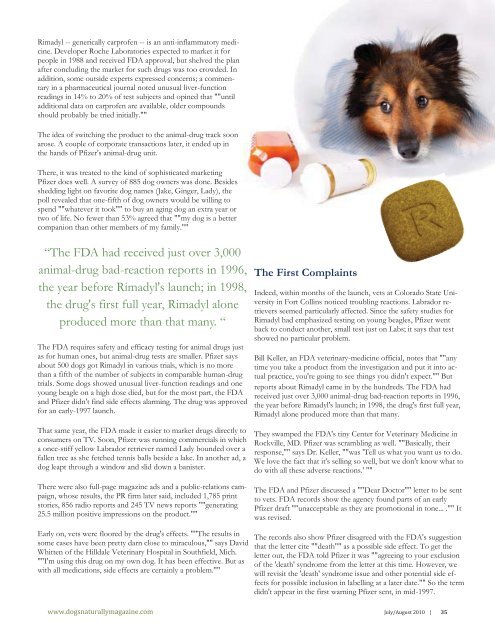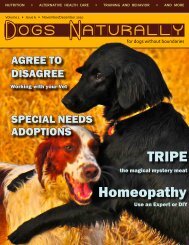July/August 2010 - Dogs Naturally Magazine
July/August 2010 - Dogs Naturally Magazine
July/August 2010 - Dogs Naturally Magazine
You also want an ePaper? Increase the reach of your titles
YUMPU automatically turns print PDFs into web optimized ePapers that Google loves.
Rimadyl -- generically carprofen -- is an anti-inflammatory medicine.<br />
Developer Roche Laboratories expected to market it for<br />
people in 1988 and received FDA approval, but shelved the plan<br />
after concluding the market for such drugs was too crowded. In<br />
addition, some outside experts expressed concerns; a commentary<br />
in a pharmaceutical journal noted unusual liver-function<br />
readings in 14% to 20% of test subjects and opined that ""until<br />
additional data on carprofen are available, older compounds<br />
should probably be tried initially.""<br />
The idea of switching the product to the animal-drug track soon<br />
arose. A couple of corporate transactions later, it ended up in<br />
the hands of Pfizer's animal-drug unit.<br />
There, it was treated to the kind of sophisticated marketing<br />
Pfizer does well. A survey of 885 dog owners was done. Besides<br />
shedding light on favorite dog names (Jake, Ginger, Lady), the<br />
poll revealed that one-fifth of dog owners would be willing to<br />
spend ""whatever it took"" to buy an aging dog an extra year or<br />
two of life. No fewer than 53% agreed that ""my dog is a better<br />
companion than other members of my family.""<br />
“The FDA had received just over 3,000<br />
animal-drug bad-reaction reports in 1996,<br />
the year before Rimadyl's launch; in 1998,<br />
the drug's first full year, Rimadyl alone<br />
produced more than that many. “<br />
The FDA requires safety and efficacy testing for animal drugs just<br />
as for human ones, but animal-drug tests are smaller. Pfizer says<br />
about 500 dogs got Rimadyl in various trials, which is no more<br />
than a fifth of the number of subjects in comparable human-drug<br />
trials. Some dogs showed unusual liver-function readings and one<br />
young beagle on a high dose died, but for the most part, the FDA<br />
and Pfizer didn't find side effects alarming. The drug was approved<br />
for an early-1997 launch.<br />
That same year, the FDA made it easier to market drugs directly to<br />
consumers on TV. Soon, Pfizer was running commercials in which<br />
a once-stiff yellow Labrador retriever named Lady bounded over a<br />
fallen tree as she fetched tennis balls beside a lake. In another ad, a<br />
dog leapt through a window and slid down a banister.<br />
There were also full-page magazine ads and a public-relations campaign,<br />
whose results, the PR firm later said, included 1,785 print<br />
stories, 856 radio reports and 245 TV news reports ""generating<br />
25.5 million positive impressions on the product.""<br />
Early on, vets were floored by the drug's effects. ""The results in<br />
some cases have been pretty darn close to miraculous,"" says David<br />
Whitten of the Hilldale Veterinary Hospital in Southfield, Mich.<br />
""I'm using this drug on my own dog. It has been effective. But as<br />
with all medications, side effects are certainly a problem.""<br />
The First Complaints<br />
Indeed, within months of the launch, vets at Colorado State University<br />
in Fort Collins noticed troubling reactions. Labrador retrievers<br />
seemed particularly affected. Since the safety studies for<br />
Rimadyl had emphasized testing on young beagles, Pfizer went<br />
back to conduct another, small test just on Labs; it says that test<br />
showed no particular problem.<br />
Bill Keller, an FDA veterinary-medicine official, notes that ""any<br />
time you take a product from the investigation and put it into actual<br />
practice, you're going to see things you didn't expect."" But<br />
reports about Rimadyl came in by the hundreds. The FDA had<br />
received just over 3,000 animal-drug bad-reaction reports in 1996,<br />
the year before Rimadyl's launch; in 1998, the drug's first full year,<br />
Rimadyl alone produced more than that many.<br />
They swamped the FDA's tiny Center for Veterinary Medicine in<br />
Rockville, MD. Pfizer was scrambling as well. ""Basically, their<br />
response,"" says Dr. Keller, ""was 'Tell us what you want us to do.<br />
We love the fact that it's selling so well, but we don't know what to<br />
do with all these adverse reactions.' ""<br />
The FDA and Pfizer discussed a ""Dear Doctor"" letter to be sent<br />
to vets. FDA records show the agency found parts of an early<br />
Pfizer draft ""unacceptable as they are promotional in tone... ."" It<br />
was revised.<br />
The records also show Pfizer disagreed with the FDA's suggestion<br />
that the letter cite ""death"" as a possible side effect. To get the<br />
letter out, the FDA told Pfizer it was ""agreeing to your exclusion<br />
of the 'death' syndrome from the letter at this time. However, we<br />
will revisit the 'death' syndrome issue and other potential side effects<br />
for possible inclusion in labelling at a later date."" So the term<br />
didn't appear in the first warning Pfizer sent, in mid-1997.<br />
www.dogsnaturallymagazine.com <strong>July</strong>/<strong>August</strong> <strong>2010</strong> | 35












